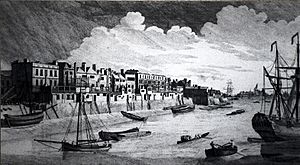HMS Hawk (1741) facts for kids
Quick facts for kids History |
|
|---|---|
| Name | HMS Hawk |
| Ordered | 25 August 1740 |
| Builder | Grevill & Whetstone, Limehouse |
| Laid down | 20 October 1740 |
| Launched | 10 March 1741 |
| Completed | 26 April 1741 at Deptford Dockyard |
| Commissioned | May 1741 |
| Out of service | October 1747 |
| Fate | Broken up, Deptford Dockyard |
| General characteristics | |
| Class and type | 8-gun Drake-class snow-rigged sloop |
| Tons burthen | 205 76⁄94 (bm) |
| Length |
|
| Beam | 23 ft 8.75 in (7.2 m) |
| Depth of hold | 9 ft 6.5 in (2.9 m) |
| Propulsion | Sail |
| Sail plan | Snow-rigged sloop |
| Complement | 80 |
| Armament |
|
HMS Hawk was a small but important warship. It was an eight-gun snow-rigged sloop (a type of sailing ship) that belonged to the Royal Navy of Great Britain. Hawk was one of three similar ships built during a conflict called the War of Jenkins' Ear against Spain. Launched in 1741, its main job was to protect other ships and patrol the Irish Sea. The ship was taken apart in 1747.
Building the Hawk
Hawk was the second of three small, fast ships. They were designed by Surveyor of the Navy Jacob Acworth. These ships were needed to protect merchant ships (ships carrying goods) in British waters. This was especially important after the war against Spain started in 1739.
The order for Hawk was placed in August 1740. It was built by Grevill and Whetstone, who were shipbuilders in Limehouse, on the River Thames. After being built, the ship was sent to Deptford Dockyard. There, it was fitted out with its equipment, weapons, and made ready for service.
Hawk was about 25.7 meters (84 feet 5 inches) long. It was 7.2 meters (23 feet 8.75 inches) wide. The ship weighed about 205 tons. Building Hawk was not very expensive. It cost £1,550 for the shipbuilders and materials. Another £1,505 was spent on its fittings and equipment.
How the Hawk Sailed and Fought
Hawk had two masts for its sails. It was a snow-rigged sloop. This meant it had square sails on its front and main masts. It also had a special small mast behind the main mast for another sail.
The ship was built with seven openings on each side for cannons. But at first, it only had eight four-pounder cannons. The other openings were left empty. It also had twelve smaller, half-pounder swivel guns. These were light weapons used against people on the deck. In 1744, two more four-pounder cannons were added. The ship needed a crew of 80 sailors to operate it.
Hawk began its service in May 1741. Its first captain was Commander William Bruce. The ship's first mission was to protect British whaling ships. These ships hunted whales near Spitzbergen.
After the whaling season, Hawk was sent to the Carolinas for a short time. Commander Bruce died there in June 1742. After his death, Hawk sailed back to England. It was then assigned to protect ships and patrol the Irish Sea. Commander Arthur Forrest became its new captain.
In 1744, Hawk returned to England. It was taken out of service in April for repairs and upgrades at Deptford. This cost £1,735. During this time, more cannons were added to the ship. Its masts were also made shorter. The main mast was shortened by 1.2 meters (4 feet). The front mast was shortened by 0.3 meters (1 foot).
Hawk was ready for service again in May 1744. It was relaunched in June. Its new job was to patrol the Thames Estuary. Commander Samuel Masterson was the captain. In 1745, it went back to the Irish Sea. There, it continued to protect merchant ships sailing near the British Isles. In August 1745, Commander Frederick Hyde became the captain.
Hawk was taken out of service for good in October 1747. It was then taken apart at Deptford Dockyard.


